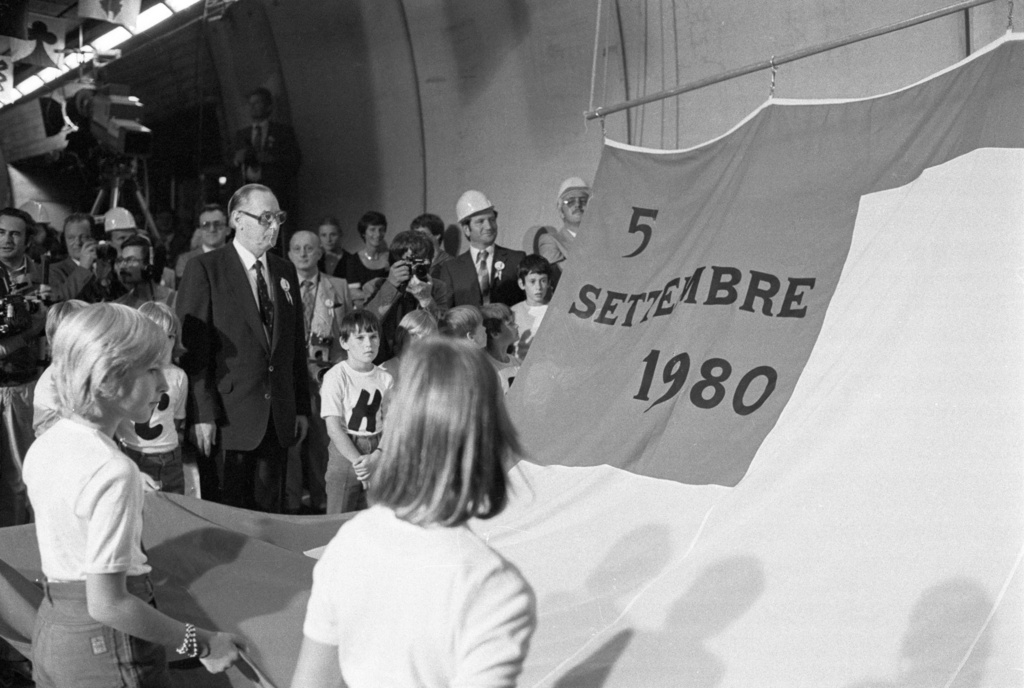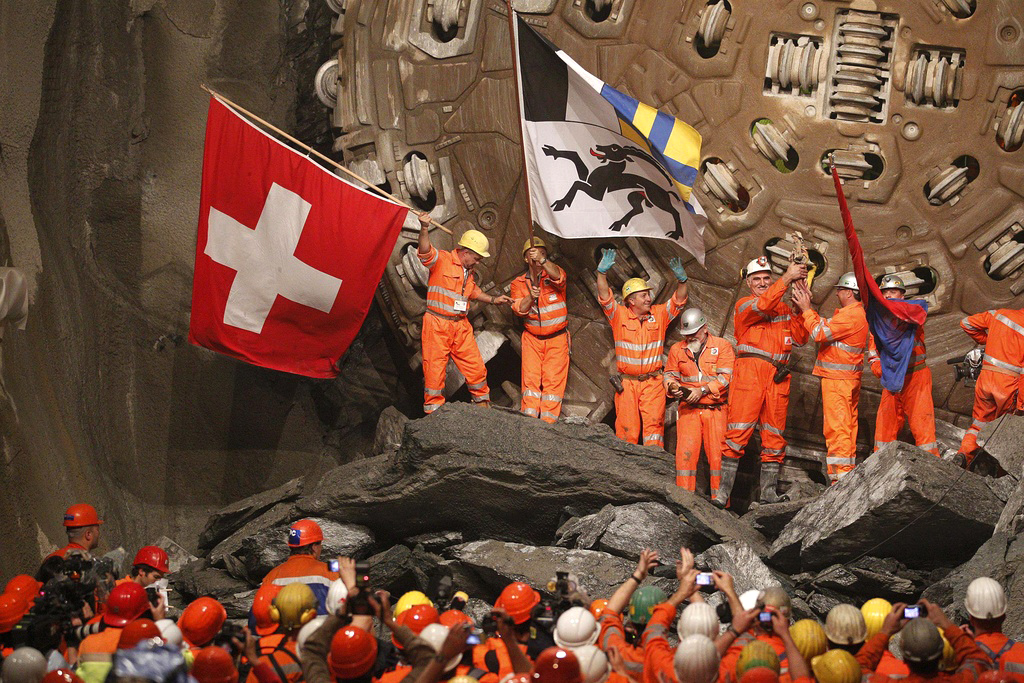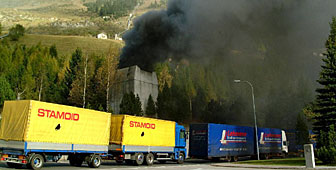Authorities accused of Gotthard tunnel vision

The Gotthard road tunnel has changed little in the ten years since 11 people died in a fire inside the key transalpine link.
The 17km tunnel is notorious for its congestion and still controversial because it remains a single bore tunnel with just one lane operating in each direction. The situation is expected to worsen when major renovation work begins.
The 30th birthday of the Gotthard road link was celebrated a little over a year ago. But the tunnel is more often associated with a different, darker episode.
On October 24, 2001, a large fire broke out after two trucks collided and the fuel tank of one of the vehicles ruptured. An investigation into the accident found that most of the 11 people killed died of asphyxiation from the toxic gas which filled the tunnel. The structure remained closed for several months.
Ten years later, the tunnel is again the focus of debate, both of a political and technical nature. It is due for a complete overhaul within the next ten to 15 years. The government favours closing the tunnel for various lengths of time, either for about 2.5 years if it is closed year round, or for approximately 3.5 years if it were kept open in the busy summer season.
Opinions differ on how to do that without too much disruption to north-south traffic flows. One possible solution would be to build a second tunnel as soon as possible, or to transfer all of the traffic from road to rail, taking advantage of the new Gotthard Base Tunnel that is scheduled to open in 2016. The latter option is favoured by the environmental organisation, Alpine Initiative.
Safer option
The engineer Giovanni Lombardi, responsible for the construction of the road tunnel more than 30 years ago, said that the initial project idea in the 1960s and 1970s was to have a two-bore tunnel that would separate opposing traffic since “it would have been safer”.
Lombardi said however that the government presented a proposal to parliament that foresaw only a single-bore tunnel, arguing at the time that traffic would never be excessive, and that vehicles could also use the higher alpine pass roads during busy holiday periods.
The second tunnel would only be constructed if the volume of traffic rose above one million vehicles a year. In fact, Lombardi added, “one year after the inauguration, the tunnel was already seeing 2.5 million vehicles [today about six million] annually. But the promise was forgotten”.
After the 2001 accident, various measures were introduced to increase safety, including a maximum limit on the number of trucks allowed to use the tunnel each hour.
Despite the efforts, the situation did not change substantially.
Political considerations
Professor Rico Maggi, a transport expert at the Swiss-Italian University in Lugano, agrees with Lombardi.
“Effectively, the Gotthard was originally planned to be a part of the motorway connecting northern and southern Europe. That implied that it had to have certain safety feature standards and the capacity required for this kind of road, but the Alpine Initiative and political considerations changed the situation.”
Maggi thinks the planned closure of the Gotthard for renovation could have a significant impact on canton Ticino, which lies at the tunnel’s southern end.
“It certainly won’t be the end of Ticino since it has a dynamic economy which can adapt itself. But it’s undeniable that there will be painful consequences even if these cannot yet be quantified: the canton strongly depends on northern Switzerland and if road links are cut for any prolonged period of time companies may decide to reorganise themselves logistically or relocate.”
Business loss
Maggi says the planned closure is not only a problem for Ticino. “Companies in Zurich and [Italy’s] Lombardy will suffer if links to customers and suppliers become more costly and difficult.”
The expert is sceptical about the possible alternatives to the construction of a second tunnel to relieve traffic during the long renovation phase. “It’s utopian to think all traffic can be transferred from road to rail, and proposals to introduce a shuttle system or keep the Gotthard pass road open year round are only theoretical.”
There are also people opposed to spending billions for the new Gotthard rail tunnel if at the same time road capacity is increased.
Maggi does not agree with this argument. “The new rail tunnel has not been conceived to absorb almost all road traffic passing through the Gotthard, but rather to transfer heavy goods transport from road to rail over a period of time. It’s unthinkable to try to return to the [traffic] levels of the 1990s. It’s already a success to have evened out the volume of traffic between the two systems.”
According to Maggi, one just has to look at the situation in the rest of Europe.
“The majority of motorway tunnels are dual-bore. Therefore the question is only to do what is considered normal everywhere else. The second tunnel could be financed by the private sector – which was the case for the Channel Tunnel and the bridge between Malmö and Copenhagen – and investors would have the right to collect tolls. That would mean that the road would not automatically be preferred to the railway.”
If everything were to proceed without any hitches, Lombardi believes the second tunnel could be completed within seven to eight years. He adds that everything depends on the politicians who must decide on the issue in 2012.
The authorities say the tunnel’s road surface must be redone, as well as the structure’s intermediate ceiling plus the ventilation and drainage systems.
Also planned is a shortening of the distances between the service bays, and an increase in the width of the lanes.
The Federal Roads Office presented four options for carrying out the work: the first two have been favoured by the government.
Option 1: complete closure for 2.5 years costing SFr650 million (road works) and around SFr600 million for measures to provide alternatives for traffic during the closure.
Option 2: Closed for 280 days of the year (from September to late June) for 3.5 years. This would cost SFr752 million (road works) and SFr670 million for traffic alternatives.
Option 3: Closed for the five months of winter over 7 years. This would cost SFr890 million (road works) and SFr557 million for traffic alternatives.
Option 4: Closed for the 7 months of summer time over 5 years. This would cost SFr810 million (road works) and SFr492 for traffic alternatives.
Transport Minister Doris Leuthard says a decision will be taken next year on which option the government will choose, without providing results of any further studies on the possible consequences of the closure.
Around 1.25 million trucks passed through the Alps in 2010, according to the transport ministry – far above the target set by the government.
Swiss voters approved a proposal in the early 1990s to transfer freight from road to rail as a way of protecting the mountains from increased road traffic. The official target is to allow a maximum of 650,000 trucks per year by 2018/19, after the new railway tunnel under the Gotthard opens.
According to law, the government can submit extra measures to parliament should the target not be met.
(Translated from Italian by Dale Bechtel)

In compliance with the JTI standards
More: SWI swissinfo.ch certified by the Journalism Trust Initiative













You can find an overview of ongoing debates with our journalists here . Please join us!
If you want to start a conversation about a topic raised in this article or want to report factual errors, email us at english@swissinfo.ch.